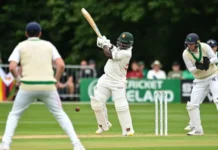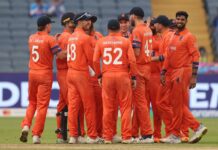Fifteen or so years ago there was a storm in a KNCB general meeting about a Board decision to promote Kampong Utrecht into the top women’s division on the grounds of the strength of their playing eleven, and we were treated to the spectacle of the Board member officially responsible, a perfectly nice man, turning slowly on a spit while assorted tribunes of the people waxed rhetorical about how terrible it all was.
Gone were the days, these tribunes declared, when the composition of the Dutch competitions was decided by administrators in smoke-filled rooms, and now everybody agreed that such matters must be decided on the field, and nowhere else.
But by a strange revolution in human affairs, these days it is the tribunes of the people who support restructuring of the competition by the fiat of a meeting, and the Board which argues that promotion and relegation ought to be settled on the pitch.
So it was that on Saturday there was a special general meeting of the KNCB to consider a proposal from a consortium of clubs led by Salland to increase next season’s Overgangsklasse, or ‘Transitional League’ (effectively the fourth division of the men’s domestic competition) to no fewer than four groups of eight teams, promoting 16 teams from the Tweede Klasse (or fifth division) at the stroke of a pen.
Furthermore, it was also proposed that the Eerste (or third) Klasse, currently a ten-team competition, should be doubled from 2025.
Why, you may be asking, does any of this matter: if Dutch recreational cricketers want to call their competition the Fantastic Elite Super League or something, why should anyone give a damn?
The answer is that it matters because tinkering with the pyramid of domestic competition can ultimately represent a threat to the delicate balance between pleasure in the recreational game and high performance (from which the KNCB derives the vast bulk of its income), and because at times such technical questions look very like a stalking-horse for a much larger culture war.
To be fair, at the roots of some clubs’ concerns was a genuine issue: after many years of decline recreational cricket is again growing in the Netherlands, and there are clearly players, often with an immigrant background, who find themselves playing at a level which is, or which they believe to be, lower than it ought to be.
The existing promotion and relegation system – one up and one down in divisions of eight – is, according to the critics, not quick or flexible enough to rebalance the system, and hence the need for a more dramatic change, even at the cost of creating an unwieldy bulge in the middle of the pyramid.
In a generally good-tempered and thoughtful debate on Saturday, this case was challenged on several grounds: wasn’t it unfair for clubs not to have known in the 2023 season what it was they were playing for? Didn’t players wind up in a given division through choices, either their own or their club’s? And wasn’t it wrong in principle to settle promotion and relegation issues anywhere other than on the field?
Behind the argument, however, there were deeper currents, structural in another way, Salland spokesman, former KNCB vice-chairman Steven Lubbers speaking darkly of ‘manipulation’ in the way the central organisation of the Bond had dealt with his group’s attempts to bring about what they claimed was rational change.
In his view, the current proposals for 2024 and 2025 were part of a longer process, initiated in 2022, to re-form the league structure over three seasons, but current chair Guido Landheer firmly denied this: the 2022 proposal to restructure the Tweede Klasse, which the Board had agreed to, had been presented at the time as a stand-alone measure, and not as part of a more concerted plan.
In the end the Salland proposal, which would have had the force of a recommendation to the Board (since constitutionally it is the latter which determines the structure and regulations of the competition), was rejected by 190 votes to 179, according to the KNCB’s weighted voting system which takes account of the number of senior, and now junior, teams fielded by each club.
That does not mean, however, that either the tensions arising from the KNCB’s very welcome growth or the deeper, underlying discontents will just go away.
Legitimate concerns were expressed about the establishment of new clubs, especially in terms of their need for adequate facilities and, in some cases, the travel demands their locations may impose, and questions were also raised about the long-running issue of umpiring in the lower divisions, where player-umpires are often accused of cheating.
These, one might think, are more significant matters than the presence of both weak and strong teams in a single pool, which is probably insoluble but which might in any case be better addressed by, for example, moving to a two up-two down system.
Prudently, the Board announced that it had asked Adriaan van den Dries, a respected former umpire and a man generally regarded as a safe pair of hands, to review the entire competition structure in consultation with the clubs, and to bring forward proposals for an improved structure.
One of his starting points, no doubt, will be the 2021 report of the Competition Task force, which seems to have been lost sight of in the governance meltdown that soon followed, with a Board at war with itself and a period of instability which Landheer’s new Board is still trying to work its way out of.
The animosities which then threatened to reduce the KNCB to chaos are to a degree still there, and perhaps underlie the real sense of frustration expressed by some club representatives on Saturday.
Tensions between the clubs and the KNCB’s central organisation of Board and office are certainly not new, and despite the Board’s regular presentation to its member clubs of an annual plan based on its multi-year strategic document, the clubs clearly feel that they are not being sufficiently consulted, either about the overall direction of travel or the detailed implementation of the strategy.
Landheer began by invoking the ‘passion for cricket’ which had brought the meeting together, and this was echoed in the traditional closing remarks by Rood en Wit chairman Cees Bieren. But like the Spirit of Cricket, it is one thing to talk about passion for the game, and another thing entirely to ensure that everyone involved in what is still a very small and existentially threatened sport in the Netherlands is working together on a common agenda.
That, on the evidence of Saturday’s meeting, is still a work in progress.
You’re reading Emerging Cricket — brought to you by a passionate group of volunteers with a vision for cricket to be a truly global sport, and a mission to inspire passion to grow the game.
Be sure to check out our homepage for all the latest news, please subscribe for regular updates, and follow EC on Twitter, Facebook, LinkedIn and YouTube.
Don’t know where to start? Check out our features list, country profiles, and subscribe to our podcast. Support us from US$2 a month — and get exclusive benefits, by becoming an EC Patron.







